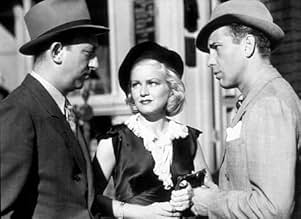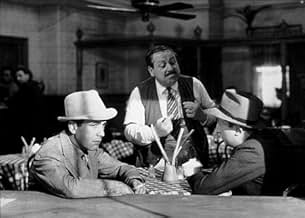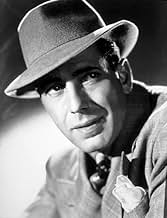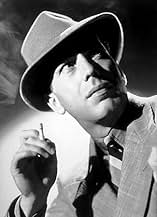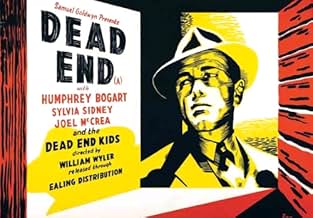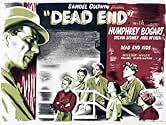IMDb RATING
7.2/10
9.2K
YOUR RATING
The lives of a young man, a young woman, an notorious gangster, and a group of street kids converge one day in a volatile New York City slum.The lives of a young man, a young woman, an notorious gangster, and a group of street kids converge one day in a volatile New York City slum.The lives of a young man, a young woman, an notorious gangster, and a group of street kids converge one day in a volatile New York City slum.
- Director
- Writers
- Stars
- Nominated for 4 Oscars
- 1 win & 4 nominations total
Leo Gorcey
- Spit
- (as Leo B. Gorcey)
- Director
- Writers
- All cast & crew
- Production, box office & more at IMDbPro
Featured reviews
Dead End is one of my personal favorites, as I watch it 10 or more times a year. The 1930's New York City setting lends itself to a host of interesting perspectives. The talent assembled for this production is why the film withstands the test of time and makes Dead End a movie which I never get tired of viewing. Greg Toland's cinematography is masterful. Max Steiner's musical score is brilliant. He perfectly blended the feel of a fast paced urban theme which then becomes a beautiful and dramatic orchestral piece. Max Steiner had a real genius for bringing the right mood to whatever the film demanded. Of so many brilliant Steiner scores, I find this to be among his finest. William Wyler's direction is awesome, as always. I particularly like the constant background flow of pedestrians going about their day throughout the entire picture. The movie's cast is stuffed with talent. Character actors like Marjorie Mane and Esther Howard fill small segments with memorable scenes. Claire Trevor's portrayal of a sweet girl who became disillusioned and wound up as a prostitute, is poignant while remaining gritty and realistic. The Dead End Kids are great throughout the movie. Ward Bond brings a plus to the movie in his role as the upscale apartment's doorman. I like Allen Jenkins and think no other actor was better suited to play the sidekick to Bogart's character as the prodigal gangster, returning to his old neighborhood. Dead End is one film that has countless elements to enjoy. The level of talent on both sides of the camera keep me watching it over and over again.
Considering all the talent involved, it was hardly surprising to find this a first rate movie. Didn't you want to slap Bogart around ... well, that is actually what compelled me to make this entry. Among the handful of superlative cameo (say 2 to 8 minutes in length)performances I have seen in my 40 plus years of movie-going, Dead End features one of them.
Marjorie Main, almost as unlikely a film character (think Ma Kettle!) as one could imagine, turned in what I consider a masterpiece. Read that she repeated her stage role, and wow, that slap, that dialog and that role. Bravo!
Marjorie Main, almost as unlikely a film character (think Ma Kettle!) as one could imagine, turned in what I consider a masterpiece. Read that she repeated her stage role, and wow, that slap, that dialog and that role. Bravo!
It offers a vivid portrait of people caught up in a continual fight to somehow satisfy themselves despite the oppressive environment that seemed to quiet their every attempt
Joel McCrea is a frustrated architect who dreams of tearing down the slums and Sylvia Sidney portrays a shopgirl struggling for identity and meaning in her life, a life made even more complicated by having to look after her brother (Billy Halop). The boy idolizes the decadent Bogart, an excessive admiration shared by the rest of the Dead End Kids, here recreating their original Broadway roles with noisy good humor
Opposing these idealists is their real threat, Bogart, an assassin named Baby Face Martin Bogart is impolitely rejected by a mother (Marjorie Main) who hates him and an ex-girl friend (Claire Trevor) who leaves him bitter and disillusioned when he discovers that she has become a hooker
Rebuked by those he had been sentimental enough to want to visit, he rapidly reverts to represent beforehand and plans a kidnapping in order to rescue something from the consumed affair
"Dead End" remains one of Bogart's best films, where the actor proves that he is capable of handling difficult material with considerable skill
Joel McCrea is a frustrated architect who dreams of tearing down the slums and Sylvia Sidney portrays a shopgirl struggling for identity and meaning in her life, a life made even more complicated by having to look after her brother (Billy Halop). The boy idolizes the decadent Bogart, an excessive admiration shared by the rest of the Dead End Kids, here recreating their original Broadway roles with noisy good humor
Opposing these idealists is their real threat, Bogart, an assassin named Baby Face Martin Bogart is impolitely rejected by a mother (Marjorie Main) who hates him and an ex-girl friend (Claire Trevor) who leaves him bitter and disillusioned when he discovers that she has become a hooker
Rebuked by those he had been sentimental enough to want to visit, he rapidly reverts to represent beforehand and plans a kidnapping in order to rescue something from the consumed affair
"Dead End" remains one of Bogart's best films, where the actor proves that he is capable of handling difficult material with considerable skill
The main credit of "Dead End" lies in the stunning visual beauties. The studio reproduction of a New York slum is really magnificent, worth of other major achievements of the same kind, like, say, the set of "Rear Window". A true joy for the eyes. The work of the camera and William Wyler's direction are outstanding, as well. And, of course, the job of the cast is great. Bogart, still in the role of the villain, McCrea and Sylvia Sidney are excellent, and save their rather straightforward characters and lines. In my opinion, the best one is Claire Trevor, in the small part of the lost girl. I normally dislike kids on the screen, but I must concede that here they give great performances, playing the gang of street-boys.
The story is conventional, with a noble message, but few and predictable twists. The script is often clumsy and preachy. Luckily enough, the director gives a quick pace to the narration and inserts a number of humoristic touches. There's a main flaw in the plot: I think that, even in the States of the 1930s, a common citizen couldn't freely shoot a gangster.
Anyway, I've found in the screen-play an interesting and modern theme, namely the psychological ambiguity of some characters, whom even the all-knowing viewer cannot fully understand. For instance, Claire Trevor is apparently the cliche disgraced girl, the innocent victim of poverty, lack of opportunities, social injustice. To end as a prostitute is her unavoidable doom... But, when her former boy-friend Bogie gives some money to help her, she makes the horribly vulgar request of "twenty more bucks"... with a grimace worth of a hardened prostitute (great stuff by Trevor!). So we see that, after all, perhaps that girl is not so innocent as she pretends to be... And what about Drina's brother, the leader of the street-boys? The audience is perfectly aware that, in spite of his whining, weeping self-apologies (when he's in dire straits), the boy is a REAL criminal. We see that he deliberately harms people, steals, brutally thrashes the rich kid, wants to slash his gang-mate. And he just mocks his affectionate sister and his friend McCrea when, in tears, he cries that he's good, that he didn't intend to harm, and all that. So, are we supposed to feel sympathy for this hideous boy? Interesting ambiguity, which creates a fine artistic effect... perhaps beyond the actual intentions of the writer Lillian Hellman.
All in all, we may forgive the defects of the movie. it is worth seeing "Dead End", enjoying the beauty of the set and the work of director and actors.
The story is conventional, with a noble message, but few and predictable twists. The script is often clumsy and preachy. Luckily enough, the director gives a quick pace to the narration and inserts a number of humoristic touches. There's a main flaw in the plot: I think that, even in the States of the 1930s, a common citizen couldn't freely shoot a gangster.
Anyway, I've found in the screen-play an interesting and modern theme, namely the psychological ambiguity of some characters, whom even the all-knowing viewer cannot fully understand. For instance, Claire Trevor is apparently the cliche disgraced girl, the innocent victim of poverty, lack of opportunities, social injustice. To end as a prostitute is her unavoidable doom... But, when her former boy-friend Bogie gives some money to help her, she makes the horribly vulgar request of "twenty more bucks"... with a grimace worth of a hardened prostitute (great stuff by Trevor!). So we see that, after all, perhaps that girl is not so innocent as she pretends to be... And what about Drina's brother, the leader of the street-boys? The audience is perfectly aware that, in spite of his whining, weeping self-apologies (when he's in dire straits), the boy is a REAL criminal. We see that he deliberately harms people, steals, brutally thrashes the rich kid, wants to slash his gang-mate. And he just mocks his affectionate sister and his friend McCrea when, in tears, he cries that he's good, that he didn't intend to harm, and all that. So, are we supposed to feel sympathy for this hideous boy? Interesting ambiguity, which creates a fine artistic effect... perhaps beyond the actual intentions of the writer Lillian Hellman.
All in all, we may forgive the defects of the movie. it is worth seeing "Dead End", enjoying the beauty of the set and the work of director and actors.
Now here's a fascinating world from the late 1930s, where they're not really angels but they still have faces dirty, where the rich butt up with poor, as they wander through their backdoor, and the disconnect provokes and displeases. The kids of the Dead End are always causing trouble, as they live their lives in a ghetto like bubble, observed by 'Baby Face' Martin, who's returned to be disheartened, this villain prefers knife over knuckle. You're left with a feeling that the worlds on the cusp, a self-destructive nature that might leave it in dust, but four years later a falcon will rise, and a year after that a white house will surprise.
Did you know
- TriviaWilliam Wyler gave Claire Trevor an old purse and broken high heel shoes. He had her minimize her make-up and ordered her not to comb her hair when she got up in the morning. He wanted her to look like the downtrodden character she was playing.
- GoofsBaby Face Martin suddenly appears from nowhere and is leaning against a railing as the boys are fighting.
- Crazy creditsOpening credits prologue: Every street in New York ends in a river. For many years the dirty banks of the East River were lined with the tenements of the poor. Then the rich, discovering that the river traffic was picturesque, moved their houses eastward. And now the terraces of these great apartment houses look down into the windows of the tenement poor.
- ConnectionsFeatured in AFI Life Achievement Award: A Tribute to William Wyler (1976)
- SoundtracksBoo-Hoo
(1937) (uncredited)
Music by Carmen Lombardo and John Jacob Loeb
Lyrics by Edward Heyman
Played at the upstairs party and sung by Huntz Hall in the street
- How long is Dead End?Powered by Alexa
Details
Box office
- Budget
- $300,000 (estimated)
- Runtime1 hour 33 minutes
- Color
- Aspect ratio
- 1.37 : 1
Contribute to this page
Suggest an edit or add missing content



